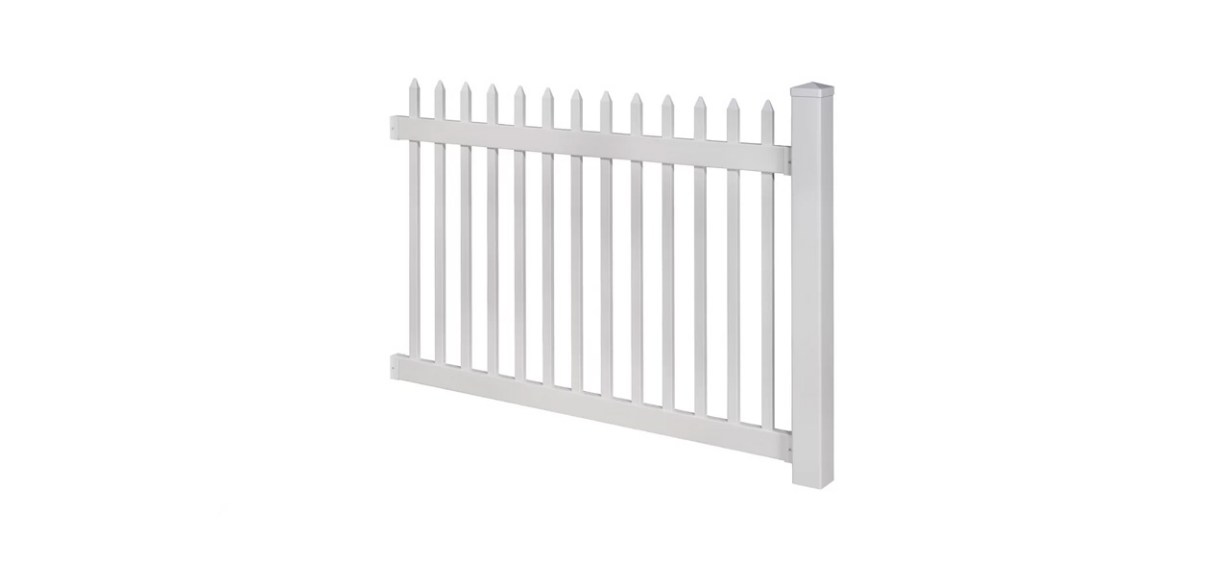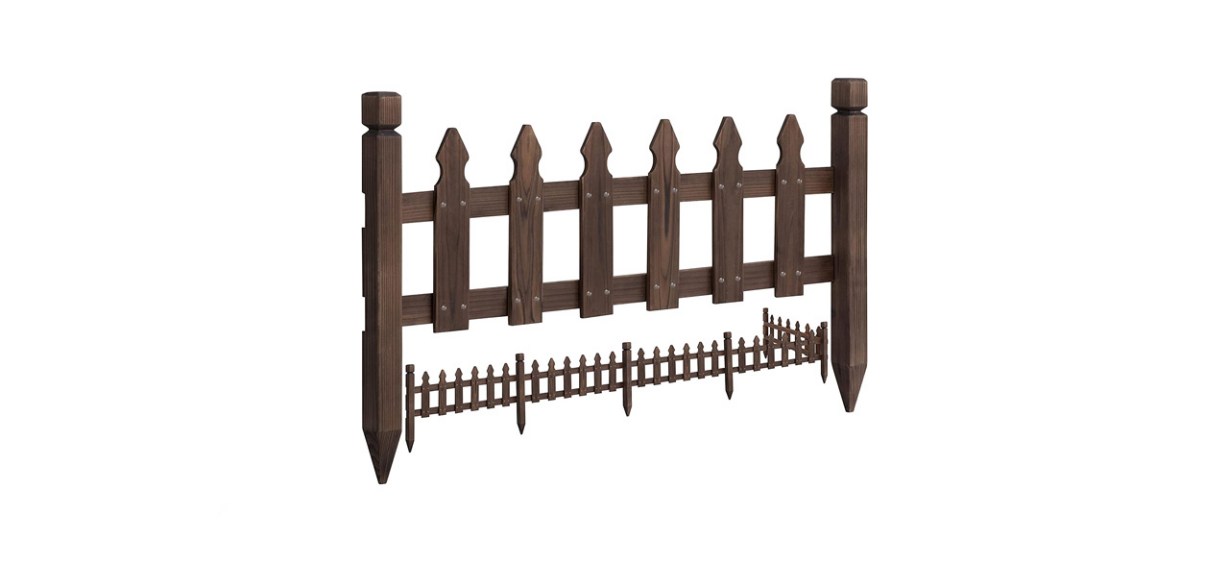Which picket fence is best?
The right picket fence can add a personal touch to your front or backyard while deterring unwanted animals such as dogs or even deer from entering. It can also keep pets and young children inside the yard, protecting them from potential dangers on the road. These small fences come in many colors, shapes, sizes and styles, making them both functional and aesthetic. The best prebuilt picket fence is the WamBam Fence No-Dig Permanent Nantucket Vinyl Picket Fence Panel because it’s easy to install, has a classic design and offers many practical benefits.
What to know before you buy a picket fence
Intended purpose
Picket fences can be used for many purposes, including:
- Keep people or dogs from entering your yard uninvited
- Discourage deer from getting to your garden
- Obstruct the view of your front or back yard for added privacy
- Prevent dogs from escaping the yard, especially if you have an invisible fence, too
- Discourage children from leaving the property unattended
- Add to the overall decor or highlight specific sections of the property
- Establish property lines for yourself, neighbors or service people
- Serve as a place for climbing plants to grow and flourish
When choosing one, consider your main goal or goals first. Taller fences with thicker pickets or pickets that are placed close together are generally ideal for security or privacy purposes. Those that have sharp tips can also help keep intruders out.
Coverage and measurements
Although there are some design variations, picket fences all follow a similar setup, which is:
- Pickets: The pickets are the vertical structures that make up the majority of the fence. Between every picket is a gap that varies in spacing. This gap is also present between the posts and the pickets. A larger gap means fewer pickets.
- Posts: These are inserted into the ground and add to the fence’s stability. The post height affects how deep you can dig into the ground for positioning purposes. Some areas have local building codes with rules on this, so check those before getting a fence.
- Rails: These run horizontally across each picket to connect them and add stability to the entire structure. They also connect to the posts.
When adding any kind of fence to your yard, measure and plan out the area you want to be contained first. That way, you can get an idea of how large of a fence you need and get an estimate of the project’s cost. There are some online calculators you can use to figure out the size and number of posts and pickets you need.
Rules and considerations
If you’re part of a Homeowners Association, there are certain rules you must follow. In some neighborhoods, this includes restrictions on the exterior of your home and the structures you install, including fences. Make sure the fence you want corresponds to the Association’s rules, especially regarding the height, size and overall aesthetic.
Before putting up a fence, it’s also important to know the exact location of your property line. If you install a fence in a neighbor’s yard by mistake, you could be required to remove it. Consider hiring a licensed surveyor to figure out where the property lines are.
What to look for in a quality picket fence
Style and design
Most picket fences follow the same kind of general design. There are a few different styles and themes, though, which can change the overall look of your front or backyard. These include:
- Simple and classic spear style where the pickets have a single triangular point at the top and feature straight lines all the way down.
- Functional spear style which looks similar but has points designed to also help shed excess water.
As for the pickets, here are some common styles:
- Pointed top
- Rounded sections
- Geometric shapes
- Distinct or uniform patterns
The posts of the fence can also be decorative. Some are sharper at the top, while others are flat and more decorative. A few are rounded or have an aesthetic piece at the top.
Some fences incorporate latticework or have irregular heights throughout to catch the eye. Many are rectangular, but some are designed with an arc-like shape.
Material
The primary materials used in a picket fence help determine how durable it is and how much maintenance is needed. Maintenance includes repainting, cleaning and fixing loose pickets. Common materials include:
- Metal: Many fences incorporate metal, such as steel and lightweight aluminum, into their design. Metal is durable and unlikely to fall over, crack or break. Certain metals, such as galvanized steel, are also less prone to corrosion or rust.
- Wood: Traditional picket fences consisted of wood, such as cedar, pine or spruce. The main advantage of wood is that it’s easy to paint. Some wood types, including cedar, are also resistant to warping or water damage.
- Vinyl or polyvinyl chloride: Highly durable and low-maintenance, this is a great option for those who want something that lasts. This material can stand up against harsh environmental conditions, though it doesn’t always handle direct sunlight well.
- Composite: Composite consists of wood, plastic and other materials to create a durable fence. These fences are generally weather-resistant and lightweight. They’re also more budget-friendly than solid wood or certain metals.
Assembly
When it comes to purchasing and assembly, here are the main options:
- Prefabricated fences: These come already assembled and are easy to install. They do not require specific measurements. Design options are sometimes limited.
- Ready-to-assemble fences: With these, you get all the necessary pickets, posts and rails. You simply need to assemble them.
- Do-it-yourself fences: These are ideal for those who want a more custom option, but they do require some know-how and patience.
Alternatively, you can opt for a professional to help you assemble and install your fence.
How much you can expect to spend on a picket fence
The cost depends on the materials, the size and whether you plan to install it yourself or with a professional. Smaller fences cost around $50, while larger ones cost about $140. Larger projects with a professional installation service range from around $200-$1,000 or so.
Picket fence FAQ
Can I design my own fence?
A. Yes, but it requires specific materials and tools. For example, you might need something to cut the wood into the desired shape and size. You also need safety equipment, measuring tape, a post level, stakes and gravel or dirt to position the fence upright. Some places, such as Home Depot, can help you create a fence and install it for you. Alternatively, you can get a contractor to help build it.
What are some alternatives to a picket fence?
A. If you’re looking for privacy and decor, plant some large bushes, hedges or trees to help conceal your yard. Brushwood and bamboo are also good options. Alternatively, put up a stone wall for added security and separation from the neighbors, sidewalk or road.
What’s the best picket fence to buy?
Top picket fence
WamBam Fence No-Dig Permanent Nantucket Vinyl Picket Fence Panel
What you need to know: This vinyl picket fence is easy to assemble and has a classic design.
What you’ll love: Weather-resistant and durable, this fence comes with either pointed or flat top pickets. It’s professional-grade and doesn’t require much work to put it together. All that’s needed is a hammer to drive the posts into the ground. It comes with 13 pickets and is 72 inches wide by 48 inches tall.
What you should consider: It’s not very tall.
Where to buy: Sold by Home Depot and Wayfair
Top picket fence for the money
Zippity Outdoor Products Permanent All American Vinyl Picket Fence Panel Kit
What you need to know: This affordable picket fence kit does not require digging, making it easy to install.
What you’ll love: Made of durable vinyl, this kit comes with a fence panel, a post, four brackets, a cap and one pipe anchor. It has a swooped picket design that adds to the overall design of the fence. It stands at 3.5 feet tall and 6 feet wide.
What you should consider: It’s easy to install on flat terrain, but slopes can make it tricky to assemble.
Where to buy: Sold by Home Depot
Worth checking out
Topeakmart Wood Picket Garden Fence Edging Fencing Garden Yard Border
What you need to know: This short picket garden fence is ideal for those who want to add decor to their garden or yard.
What you’ll love: It comes in three sizes. Each individual section is 21.7 inches tall by 35.5 inches long. The fence consists of natural fir wood that’s been treated so it keeps its shape for a long time.
What you should consider: The fence is rather short because it’s really meant for a garden, not a yard.
Where to buy: Sold by Amazon
Want to shop the best products at the best prices? Check out Daily Deals from BestReviews.
Sign up here to receive the BestReviews weekly newsletter for useful advice on new products and noteworthy deals.
Angela Watson writes for BestReviews. BestReviews has helped millions of consumers simplify their purchasing decisions, saving them time and money.
Copyright 2022 BestReviews, a Nexstar company. All rights reserved.




